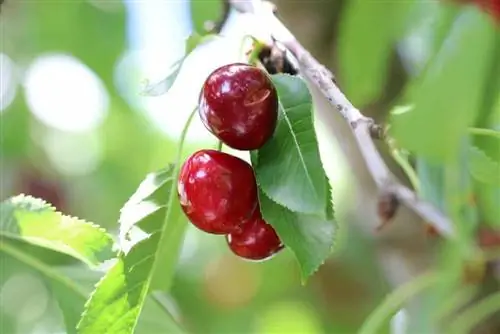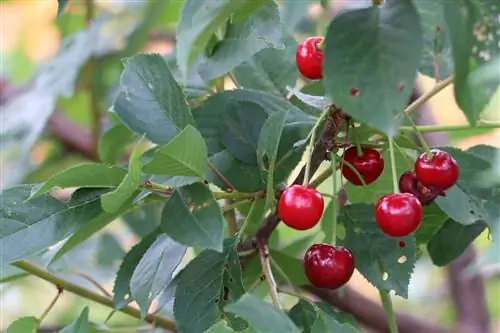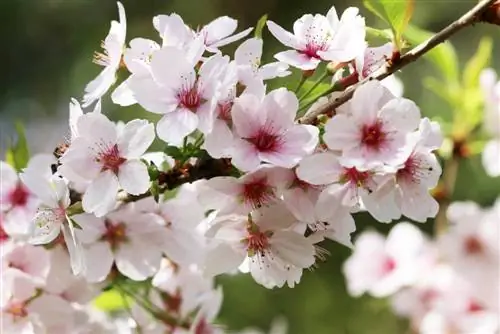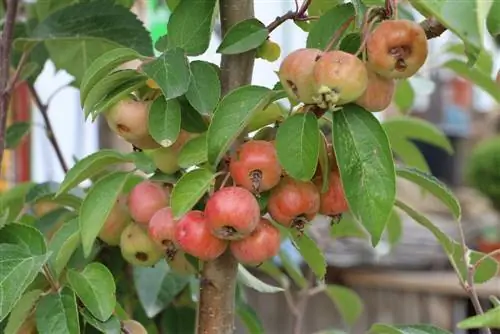- Author admin [email protected].
- Public 2023-12-17 03:39.
- Last modified 2025-06-01 06:48.
The sweet cherry (Prunus avium) belongs to the rose family and is closely related to other stone fruits such as plum (Prunus domestica), peach (Prunus persica), apricot (Prunus armeniaca) and of course sour cherry (Prunus cerasus). It is a cultivated form of the small-fruited bird cherry that has been growing wild in Europe, the Middle East and the Caucasus since ancient times. Old varieties of sweet cherries can grow up to 20 meters high and also develop very wide crowns - so it's no wonder that they are now preferred to be grafted onto weakly growing rootstocks. However, this does not apply to the columnar cherry, because it is a particularly slim, low-growing variety.
What is a columnar cherry anyway?
The slender columnar cherry is by no means an invention of modern and enterprising nurseries. Instead, columnar fruit has a centuries-old tradition. Resourceful breeders have repeatedly crossed naturally narrow trees with a pronounced central axis and few side shoots and selected the resulting offspring for the desired characteristics, ultimately resulting in various varieties of very slender and rather low-growing sweet cherries. Another typical feature of this growth habit is the fact that flowers and fruits develop directly on the trunk. Even if the appearance of a columnar cherry seems a bit unusual at first, it is still a completely normal Prunus avium - which has only been given this special growth habit through breeding selection. Real columnar cherries grow to a height of around two to a maximum of three meters and can usually be cultivated very well in pots.
Benefits of a columnar cherry
The advantages of the comparatively low and narrow columnar cherry are obvious: These cherry trees also grow in very small gardens, even in the front garden or in a sufficiently large pot on the balcony or terrace. This means that even non-garden owners or those who only have a small garden can enjoy sweet cherries from their own harvest. Real columnar cherries don't even have to be cut back particularly hard to keep them artificially low and narrow: Since the trees grow like this naturally, only corrective pruning measures are necessary.
Caution - there isn’t always a columnar cherry inside where it says “columnar cherry”
But be careful when buying, because “pillar cherries” are often sold even though they are sweet cherries that grow normally. In the worst case, the awakening can be unpleasant if the tree, which supposedly remains low and narrow, suddenly pushes up and out in width - and can only be prevented from growing by severe pruning. However, such pruning measures usually have exactly the opposite effect: pruned trees tend to sprout again even more strongly. The result is that you have to cut your so-called “pillar cherry” more and more often and more radically from year to year. To prevent this, take a closer look at the variety label before buying and choose a real columnar cherry.
Species and varieties
There are numerous types and varieties of columnar cherries, which are usually divided into fruit-bearing and non-fruit-bearing.
Fruit-bearing and non-fruit-bearing columnar cherries
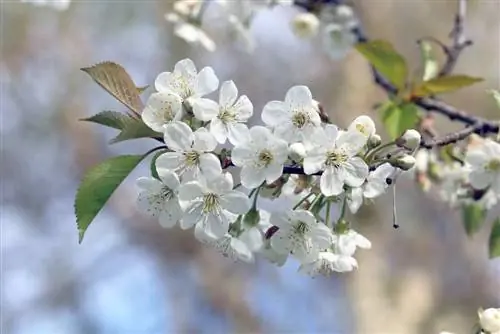
The fruit-bearing cherries include the two species sweet cherry (Prunus avium) and sour cherry (Prunus cerasus). While the sweet cherry is a tame descendant of the wild bird cherry, the sour cherry was probably created through multiple crossings between the sweet cherry and the bushy steppe cherry (Prunus fructicosa). In general, sour cherries are more robust and smaller than sweet cherries. Sometimes you can also find cultivars of the Japanese flowering cherry (Prunus serrulata) grown as columnar cherries, which, however, do not bear any fruit and are therefore purely ornamental cherries.
Self-fertilizers also prefer cross-pollination
Most columnar cherries are considered self-fertile or self-pollinating, i.e. H. If necessary, these varieties also fertilize their flowers with their own pollen and thus produce offspring (i.e. fruits). However, this behavior does not correspond to the natural drive to preserve the species, because all living things - including cherries - strive to spread their genes as widely as possible. Cross-pollination by another cherry tree guarantees he althy offspring - as is well known, inbreeding leads to questionable properties, and not just in fruit. Therefore, your self-fertile columnar cherry will always try to avoid self-fertilization - which in case of doubt can sometimes lead to no fruit being set at all.
These columnar cherry varieties are considered self-fruitful
- 'Campanilo' (both sweet and sour cherry)
- ‘Claudia’
- ‘Sara’
- 'Jachim' (variety approval only since 2013)
- ‘Stella’
- ‘Victoria’
Tip:
Of course, self-fertile varieties also need help with pollination. This job is usually done by bees and bumblebees. But if, for example, these are rarely found on your balcony on the 10th floor of a high-rise building, you can also use this trick: Take a fine brush and manually transfer the pollen from one flower to the other.
However, the following popular columnar cherries are not self-fruitful
- ‘Fruttini Garden Bing’
- 'Helene', pollinator variety 'Sylvia'
- 'Siberia', pollinator variety 'Helene'
- ‘Sylvia’, many pollinator varieties
Tip:
Many cherry varieties cross-pollinate with sour cherries as long as they bloom at the same time. When buying, pay attention to the flowering time, which is often given in “cherry weeks”. This term also indicates the ripening period, which in most regions extends between May 24th and August 20th.
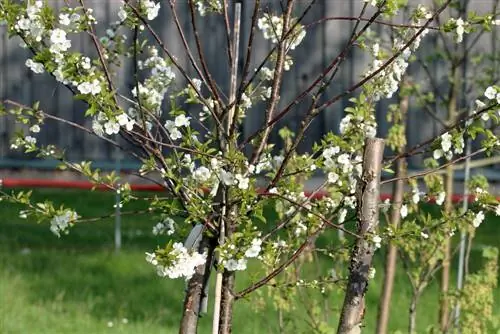
This entire period is divided into seven cherry weeks, with each cherry week lasting 11 to 14 days. However, some tree nurseries have a slightly different counting method that begins on May 1st and where each cherry week corresponds to two calendar weeks.
The most popular columnar sweet cherries
In recent years, a large number of interesting new varieties of columnar cherry have been bred. Here we have compiled the most popular ones for you:
‘Campanilo’
- as sweet and also as sour cherry
- Ripening time in the first half of July
- very large, dark red-black colored fruits
- Growth height maximum 250 centimeters
‘Claudia’
- medium-sized, red-brown fruits with deep red flesh
- Riping time third to fourth cherry week (beginning to mid-July)
- First yield from the third year
- Growth height maximum 250 centimeters
‘Sara’
- large, dark red fruits
- Riping time fourth to fifth cherry week (mid-July)
- First yield often from the second year
- Growth maximum 250 centimeters, width up to 80 centimeters
‘Stella’
- dark red, very sweet fruits
- Ripening period from the end of July to the beginning of August
- Growth height maximum 250 centimeters
‘Victoria’
- medium-sized, sweet-aromatic fruits
- Ripening period between the beginning and middle of July
- Growth height 220 to 300 centimeters, width up to 50 centimeters
‘Helene’
- large, bright red and sweet fruits
- Ripening period from the beginning of July
- Maximum growth height between 200 and 350 centimeters
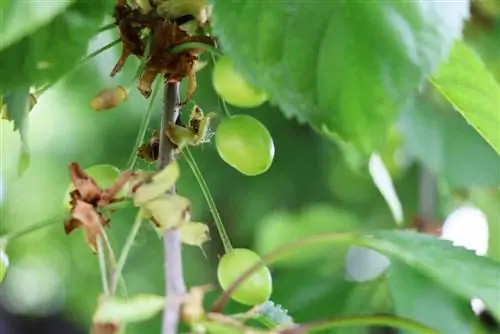
‘Sylvia’
- large, bright red and very sweet fruits
- Ripening period from July
- Maximum growth height between 300 and 350 centimeters
- The most popular sour cherries
‘Jachim’
- Variety approval only since 2013
- large, dark red fruits
- Ripening period between mid and end of July
- Maximum growth height between 200 and 350 centimeters
‘Rubina’
- large, dark red to blackish fruits
- refreshing sweet and sour taste
- Harvest time mid to late July
- self-fruitful
- Maximum growth height about 250 centimeters
‘Boaz’
- large, dark red and burst-resistant fruits
- Harvest time from mid-July
- Growth height 250 to 350 centimeters
- very robust against diseases
- self-fruitful
How to plant the columnar cherry correctly
Like all sweet cherries, columnar cherries also need deep, permeable and humus-rich soil, which is ideally both sandy and loamy as well as slightly calcareous. However, heavy, waterlogged soils are not suitable for cherry cultivation. In contrast to conventional fruit trees, pruning is not necessary. However, it makes sense to place the plant in a bucket of water for at least an hour before planting so that the roots can soak up - this will make it easier for the cherry to grow in the new location later. Otherwise, proceed as follows when planting the columnar cherry:
- optimal size of the planting hole is twice as deep and wide as the root diameter
- Improve poor soil with plenty of humus/compost
- Protect the columnar cherry with a support post from wind distortion and breakage
- This is driven approx. 30 centimeters deep into the excavated planting hole
- Fill the planting hole evenly and start
- Plant the columnar cherry exactly as deep as it was previously in the pot
- The location can be recognized by the dark discoloration of the root neck
- Finishing points should always be a hand's breadth above the ground
- Form a pouring trough and slurry it several times with water
- Attach the trunk to the support post using coconut tricks, jute strips or plastic straps
- Form spacers from fastening material
- Wrap the rope three times around the trunk and post and then wrap it starting from the trunk
Plant a columnar sweet cherry in a location that is at least bright and partially shaded; a location in full sun is better. Early varieties in particular also need a protected place that is not at risk of late frost. Columnar sour cherries, on the other hand, usually thrive very well in partial shade and on somewhat poorer soils.
Planting columnar cherries in a pot - this is what you should pay attention to
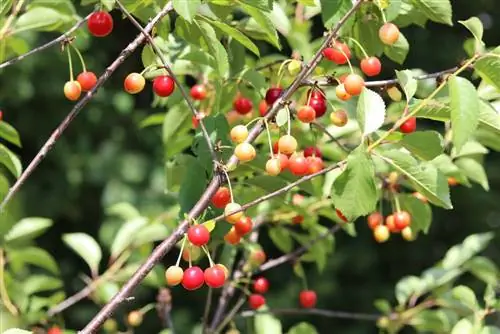
Due to their natural, slender growth habit and rather low height, columnar cherries can also be cultivated very well in sufficiently large containers. You should make sure that the plant pot you choose is neither too big nor too small. A pot that is too small will cause growth problems, while a pot that is too large will cause the tree to put its energy into root growth. It is ideal if the planter is about twice as deep and wide as the root ball. The ideal planter also has drainage holes at the bottom of the pot through which excess irrigation water can escape. If possible, do not place the pot in a planter, but rather on wooden blocks or something similar - this way the columnar cherry, which is sensitive in this regard, does not get “wet feet”. Place a few larger shards of clay over the drainage holes to prevent muddying and thus sealing, and then place a few centimeters of expanded clay or small pebbles on top as drainage. Only then do you fill in a humus-rich substrate into which the cherry tree will finally be planted. A support - for example through a support post or tying it to a fence or something similar - makes sense.
Proper care of the columnar cherry
So that the columnar cherry remains he althy and produces a strong yield, it needs species-appropriate care. Specimens planted in the garden should
- water regularly in dry times
- be supplied with compost or a potash fertilizer in spring
- No longer fertilized with nitrogen from around mid-July
- fertilize with little nitrogen at all
- and no more fertilization at all from two months before the start of winter
- This promotes the ripening of the young shoots before winter
- Keep the tree disc free by mulching
- because cherry trees without a free tree disc suffer from a lack of water, nutrients and air
- therefore do not plant columnar cherries directly in the lawn
- Cutting columnar cherries after harvest
- Pruning maintains shape and tree he alth
Care properly for a columnar cherry in a pot
Naturally, columnar cherries grown in pots need to be watered and fertilized regularly - after all, these trees cannot take care of themselves. Avoid both drying out of the substrate and too much moisture; fertilization is carried out from the first shoots until around the beginning / middle of August. During the cold winter months, protect the tree from frost with a fleece or other suitable material: The roots of potted plants are at high risk of frost due to the small amount of soil. For this reason, place the pot on a piece of Styrofoam or wood and move it against a warm house wall. Repot the columnar cherry about every two to three years or refill the used soil at least in spring.
Cutting
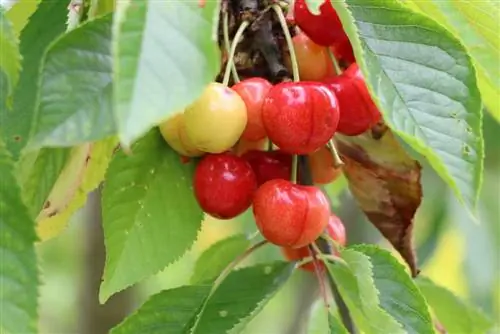
Sweet cherries are generally considered to be vigorous and sprout easily. Columnar cherries are no exception in this regard either. For this reason, careful pruning should always be carried out immediately after the harvest, which maintains the he alth of the tree and also prevents baldness from below.
- cut back all side shoots except for two to three eyes
- remove all sick and weak shoots
- remove older and heavily woody shoots
- also thin out shoots that are too close or crossing each other
- Cut the leader from a height of 100 centimeters
- this stimulates stronger side growth
- and counteracted baldness
Tip:
Check the fruit tree regularly for signs of disease or pest infestation. For example, pay attention to the appearance of resinous discharge, the so-called gum flow. In this case, you must act quickly and remove diseased trees quickly.
Conclusion
If you only have a small garden or even just a balcony, you still don't have to go without fresh cherries from your own tree. Slender columnar cherries can find enough space even in the smallest of spaces, as long as they have enough sun and permeable, humus-rich soil. Care is quite uncomplicated: the tree should be watered during dry months, fertilized appropriately during the growing season - with as little nitrogen as possible and with organic materials if possible - and also cut back immediately after harvest. Many columnar cherries are naturally self-fertile, i.e. H. they do not need a second pollinator tree.

